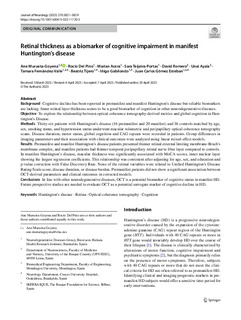Izenburua
Retinal thickness as a biomarker of cognitive impairment in manifest Huntington’s diseaseEgilea (beste erakunde batekoa)
Beste instituzio
BioCruces Health Research InstituteUPV/EHU
Hospital Universitario de Cruces
Ikerbasque
Bertsioa
Bertsio argitaratua
Eskubideak
© Tha Author(s) 2023Sarbidea
Sarbide irekiaArgitaratzailearen bertsioa
https://doi.org/10.1007/s00415-023-11720-3Non argitaratua
Journal of Neurology Vol. 270Lehenengo orria
3821Azken orria
3829Argitaratzailea
Springer NatureGako-hitzak
Huntington's diseaseretina
optical coherence tomography
cognition
Laburpena
Background Cognitive decline has been reported in premanifest and manifest Huntington’s disease but reliable biomarkers are lacking. Inner retinal layer thickness seems to be a good biomarker of cogni ... [+]
Background Cognitive decline has been reported in premanifest and manifest Huntington’s disease but reliable biomarkers are lacking. Inner retinal layer thickness seems to be a good biomarker of cognition in other neurodegenerative diseases. Objective To explore the relationship between optical coherence tomography-derived metrics and global cognition in Huntington’s Disease.
Methods Thirty-six patients with Huntington’s disease (16 premanifest and 20 manifest) and 36 controls matched by age, sex, smoking status, and hypertension status underwent macular volumetric and peripapillary optical coherence tomography scans. Disease duration, motor status, global cognition and CAG repeats were recorded in patients. Group differences in imaging parameters and their association with clinical outcomes were analyzed using linear mixed-effect models.
Results Premanifest and manifest Huntington’s disease patients presented thinner retinal external limiting membrane-Bruch’s membrane complex, and manifest patients had thinner temporal peripapillary retinal nerve fiber layer compared to controls. In manifest Huntington’s disease, macular thickness was significantly associated with MoCA scores, inner nuclear layer showing the largest regression coefficients. This relationship was consistent after adjusting for age, sex, and education and p-value correction with False Discovery Rate. None of the retinal variables were related to Unified Huntington’s Disease Rating Scale score, disease duration, or disease burden. Premanifest patients did not show a significant association between OCT-derived parameters and clinical outcomes in corrected models.
Conclusions In line with other neurodegenerative diseases, OCT is a potential biomarker of cognitive status in manifest HD. Future prospective studies are needed to evaluate OCT as a potential surrogate marker of cognitive decline in HD. [-]
Sponsorship
Gobierno VascoProjectu ID
info:eu-repo/grantAgreement/GV/Convocatoria 2019. Línea 1 Promoción de la actividad investigadora sanitaria/2019111004/CAPV/Identificación de predictores clínicos para la detección precoz de trastornos neuropsicólogos y neuropsiquiátricos severos en portadores asintomáticos y sintomáticos de enfermedad de Huntington/Bildumak
Item honek honako baimen-fitxategi hauek dauzka asoziatuta:






















